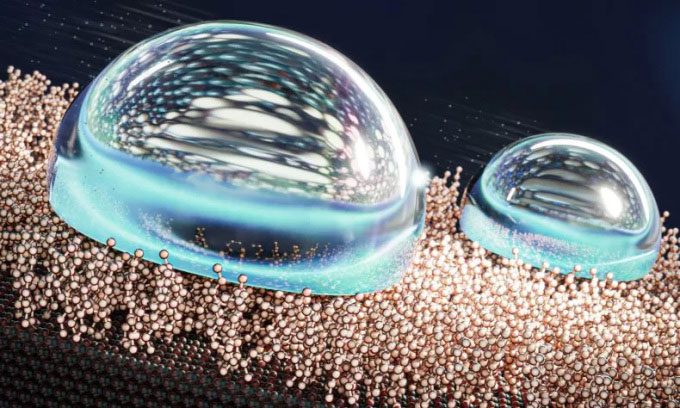Scientists Create New Material with an Outer Layer Made of Water-Repellent Molecules Bonded to a Solid Silicon Surface.
A research team from Finland, led by expert Robin Ras at Aalto University with support from scientists at the University of Jyväskylä, has developed a mechanism that enables water droplets to slide off surfaces with unprecedented efficiency. The new research was published in the journal Nature Chemistry on October 23.

Illustration of a liquid-like molecular layer repelling water droplets. (Photo: Ekaterina Osmekhina/Aalto University)
The way water adheres to or slides off surfaces impacts cooking, transportation, optics, and hundreds of other technologies. Effective water-repellent surfaces can enhance various technologies used in households and industries, such as plumbing systems, transportation, and automobiles.
In this new study, the team of experts created solid silicon surfaces with an outer layer resembling a liquid, capable of repelling water by allowing droplets to slide off the surface. This coating acts as a lubricant between the product and the water droplets.
The new discovery challenges current perceptions of friction between solid surfaces and water, opening up new possibilities for studying slipperiness at the molecular level. “Our research is the first to directly approach the nanometer level to create surfaces that are molecularly heterogeneous,” said Sakari Lepikko, a member of the research team.
By carefully adjusting factors such as temperature and the amount of water in the reactor, they were able to control the coverage range of the self-assembled monolayer (SAM) on the silicon surface. Surprisingly, even low coverage resulted in extremely high slipperiness.
Using this new method, the research team produced the world’s smoothest liquid-like surface. According to Lepikko, this discovery promises applications wherever water-repellent surfaces are needed. “It has potential applications in heat transfer in pipelines, de-icing, anti-fogging, creating self-cleaning surfaces, and even for microchannel applications where small droplets need to be moved smoothly,” Lepikko stated.
The research team intends to continue testing and improving the SAM coating. “The main issue with the SAM coating is that it is very thin and can easily disperse after physical contact. However, studying it provides foundational scientific knowledge that we can use to create long-lasting practical applications,” Lepikko added.


















































